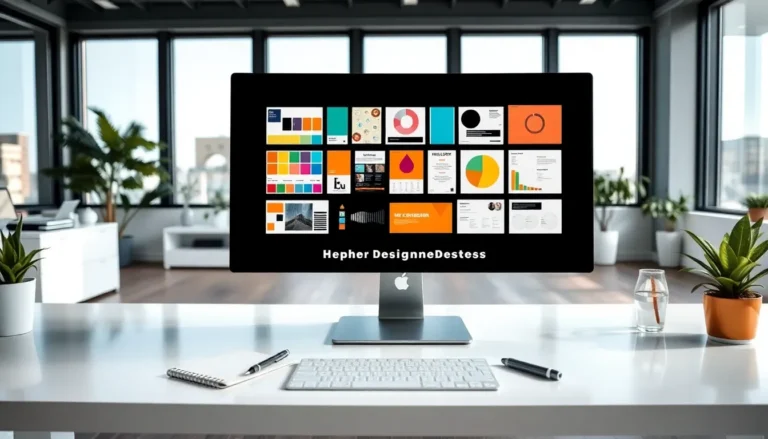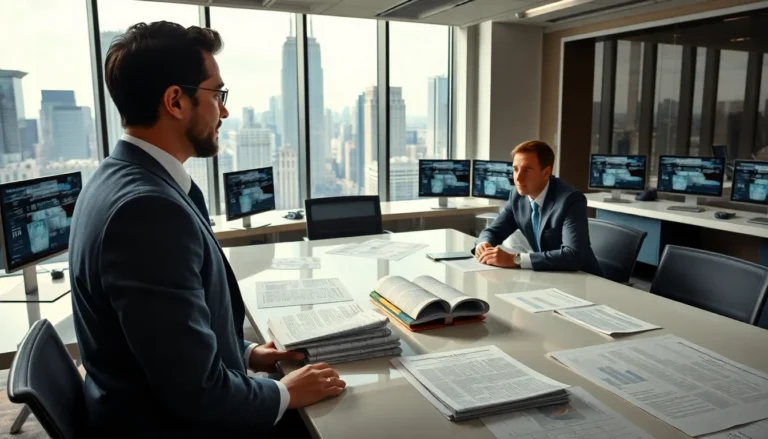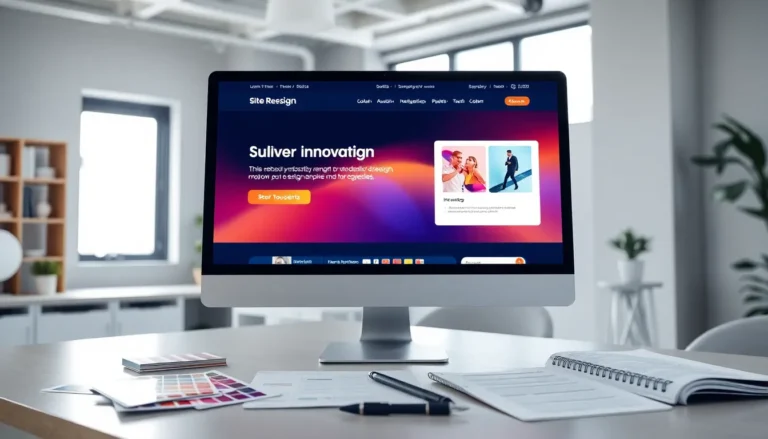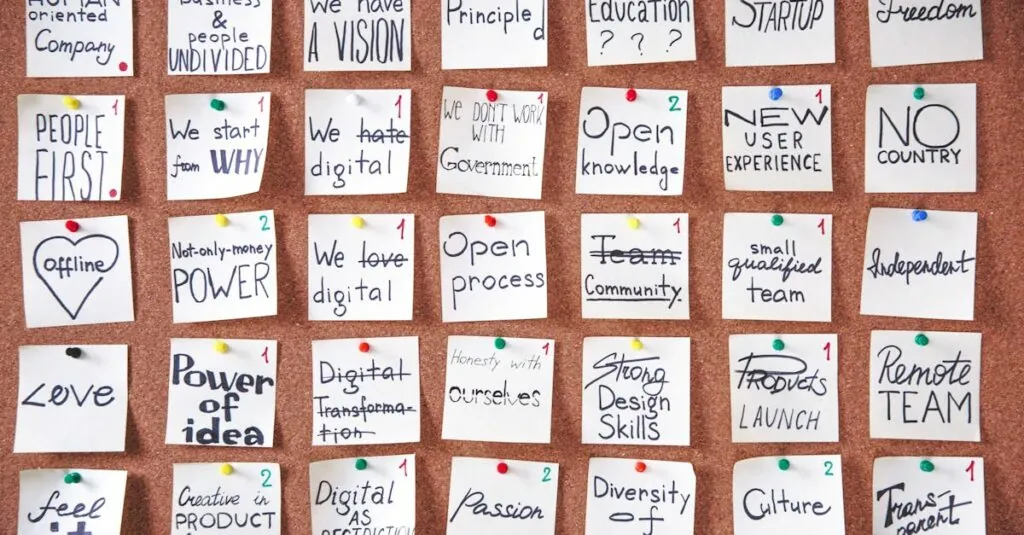Table of Contents
ToggleDesign isn’t just about making things pretty; it’s about solving problems and creating experiences that stick. Whether it’s a sleek website or a cozy coffee shop, the right design concept can transform the ordinary into the extraordinary. But what does that really mean?
Imagine walking into a room that feels like a warm hug or scrolling through a website that feels like a breeze. Those are the magic moments that great design concepts deliver. In this article, we’ll explore some standout examples that not only look good but also make you say, “Wow, why didn’t I think of that?” Get ready to dive into a world where creativity meets functionality, and maybe even chuckle a bit along the way.
Overview Of Design Concepts
Design concepts encompass a wide range of ideas that guide the creation of functional and aesthetic solutions. Each concept serves a specific purpose, often addressing particular challenges within various fields, such as architecture, interior design, or graphic design. Various principles underpin these concepts, including balance, contrast, emphasis, movement, pattern, and unity.
Balance refers to the distribution of visual weight within a design. It can be symmetrical, where elements mirror each other, or asymmetrical, offering a more dynamic arrangement. Contrast enhances the visibility of key elements by juxtaposing differing colors, shapes, or sizes, capturing user attention effectively.
Emphasis focuses on creating a focal point within a design. This can be achieved through size, color, or positioning, guiding viewers to important areas. Movement directs the viewer’s eye throughout the design, encouraging exploration of elements in a specific sequence. Pattern utilizes recurring designs or motifs to create rhythm, establishing a sense of cohesiveness and familiarity.
Unity ties all elements together, ensuring that they work harmoniously within the overarching concept. A design project that embraces unity often achieves a stronger impact, providing a smoother experience for users. These fundamental concepts can be seen in various examples, such as minimalist interior spaces that prioritize functionality or bold graphic designs that capture attention.
Incorporating these design concepts can enhance both practicality and visual appeal. Designers can create environments or visuals that resonate with users, fostering memorable interactions. Each concept plays a critical role in crafting designs that are not only eye-catching but also serve their intended purpose.
Types Of Design Concepts
Various design concepts play critical roles across multiple fields, each offering unique insights and approaches. Understanding these concepts fosters innovation in graphic, product, and interior design.
Graphic Design Concepts
Graphic design emphasizes visual communication through the strategic use of typography, colors, and images. Incorporating principles like hierarchy prioritizes information, guiding the viewer’s eye to important elements first. Utilizing grid systems ensures alignment and balance, creating a coherent layout. Designers often explore contrast, which heightens the visibility of text and images, making content more engaging. Moreover, whitespace provides breathing room, enhancing overall aesthetics and clarity. Effective branding encapsulates these elements, fostering brand recognition and loyalty.
Product Design Concepts
In product design, functionality meets aesthetics, balancing user experience and visual appeal. Designers focus on usability, ensuring products are intuitive and accessible. Ergonomics play a vital role by considering human factors, enhancing comfort and efficiency. Prototyping allows exploration of ideas, enabling adjustments before final production. Sustainability has emerged as a key consideration, with designers integrating eco-friendly materials and processes. Moreover, modularity promotes versatility, allowing customization and adaptation to user needs. Color theory impacts perception, influencing consumer choices and emotional responses.
Interior Design Concepts
Interior design combines space planning with aesthetics to create functional environments. Designers often prioritize natural light, enhancing mood and energy in a space. Accessories and furnishings contribute to the ambiance, reflecting the desired style and functionality. Color schemes evoke particular feelings, guiding choices based on the room’s purpose. Open floor plans encourage flow and interaction, promoting a sense of community within spaces. Incorporation of biophilic design elements connects occupants to nature, enhancing well-being. Attention to detail ensures that each element harmonizes, fostering a cohesive interior experience.
Key Elements In Design Concepts
Effective design incorporates key elements that enhance both aesthetics and functionality. Designers rely on specific principles to guide their creations, ensuring a coherent and engaging experience.
Color Theory
Color impacts emotions and perception significantly. It comprises three main components: hue, saturation, and brightness. Designers often use complementary colors to create contrast and focal points. Analogous colors provide harmony within a palette. Various color schemes, such as monochromatic or triadic, contribute to visual storytelling. By understanding cultural color associations, designers can convey messages that resonate with specific audiences.
Typography
Typography serves as a critical element in design, influencing readability and aesthetic appeal. It consists of typefaces, font size, line spacing, and character spacing. Choosing the right typeface affects how text is perceived and understood. Designers utilize hierarchy to guide readers through information, prioritizing important details. Consistency in typography fosters a unified look across design projects. Selecting fonts that complement the overall design aesthetic enhances user engagement and communication.
Layout and Composition
Layout and composition determine how visual elements are arranged. Focus on grid structures simplifies the organization of content. Designers balance visual weight to create harmony within a layout. Proximity plays a role in connecting related elements, while white space enhances clarity and reduces visual clutter. Movement directs the viewer’s eye across the design, helping prioritize information flow. Optimizing layout ensures that designs are both functional and visually appealing.
Real-World Design Concepts Examples
This section presents practical examples of successful designs across various fields, illustrating how effective concepts enhance user experiences.
Successful Graphic Designs
Visual communication plays a pivotal role in graphic design. Iconic examples include campaigns by Apple, known for their clean typography and strategic use of white space. Companies like Coca-Cola utilize vibrant color schemes to evoke emotion and brand recognition. Furthermore, effective layouts employ grid systems, ensuring elements are cohesively arranged for optimal visual hierarchy. Designers like Paula Scher leverage bold typefaces and dynamic imagery to create engaging narratives. All these aspects demonstrate how thoughtful graphic design captures attention and conveys messages clearly.
Innovative Product Designs
Product design focuses on blending functionality and aesthetics. The iPhone is a prime example, showcasing sleek design and intuitive usability. Designers prioritize ergonomics, ensuring that products like kitchen tools fit comfortably in hand. Brands such as IKEA emphasize sustainability through modular furniture options, appealing to environmentally conscious consumers. Another notable example is the Tesla Model S, combining cutting-edge technology with stylish form. Each aspect of these designs contributes to a seamless user experience, engaging customers and enhancing satisfaction.
Inspiring Interior Spaces
Interior design transforms spaces into functional masterpieces. The open floor plans seen in modern homes encourage light flow and social interaction. Designers like Kelly Wearstler blend textures and colors to create harmonious environments. Workspaces such as Google’s offices prioritize collaboration with vibrant communal areas. Furthermore, residential designs often highlight natural light through large windows, enhancing mood and energy. Each design choice ultimately shapes the atmosphere, improving both functionality and aesthetic appeal.
Design concepts play a vital role in shaping experiences that resonate with users. By understanding and applying principles like balance, contrast, and unity, designers can create spaces and products that not only look good but also serve a purpose. The examples discussed illustrate how innovative design can transform everyday interactions into memorable moments.
As industries continue to evolve, the importance of effective design will only grow. Embracing these concepts opens doors to creativity and functionality, ensuring that designs remain relevant and impactful. Whether in graphic, product, or interior design, the right approach can lead to extraordinary results that enhance everyday life.







